Investing
New rules on securities, banking ownership limitations in Vietnam
Published
11 months agoon
Vilaf law firm analyzes the newly-promulgated rules related to the amendments and supplements to the Law on Securities 2019; the roadmap to ensure compliance with ownership limitations of the Law on Credit Institutions 2024; and the amendments of regulations on certificates in insurance sector.

In 2024, Vietnam’s benchmark VN-Index recorded a growth of nearly 12%. Photo by The Investor/Trong Hieu.
1. Law amending nine laws
On November 29, 2024, the National Assembly passed the Law No. 56/2024/QH15 on amendments and supplements to nine (09) laws (the Amendment to 09 Laws) including, among others, the Law on Securities 2019.
The Amendment to 09 Laws will take effect from January 1, 2025 with certain amendments effective from April 1, 2025 or January 1, 2026. Among the amendments introduced by the Amendment to 09 Laws, changes to the Law on Securities 2019 are expected to attract foreign investment to the securities market, as well as to enhance market transparency and investor protection following the uncovering of recent stock manipulation cases.
Securities market manipulation
The Amendment to 09 Laws regarding the Law on Securities 2019 adds a specific definition of “securities market manipulation” to the Law on Securities 2019, combining the existing definitions of this term from Decree No. 156/2020/ND-CP on administrative penalties for violations in the securities market and the Penal Code 2015.
In particular, any of the following activities will be considered as manipulating the securities market, which shall be prohibited:
(i) using one or more of one’s own or other’ trading accounts, or conspiring to continuously buy and sell securities to create artificial supply and demand;
(ii) trading securities without actual transfer of ownership or within a closed group of traders in an attempt to establish artificial demand and/or supply and prices;
(iii) continuously buying or selling securities in dominant volumes at market opening or closing times to manipulate securities prices;
(iv) trading securities through collusion, persuading others to continuously place buy and sell orders that significantly affect supply, demand, and securities prices, thus manipulating securities prices;
(v) directly or indirectly disseminating opinions on securities and/or issuers to influence securities prices while holding them; and
(vi) using other methods or engaging in different trading actions, or combining them with spreading false rumors or providing misleading information to the public to create artificial supply and demand and manipulate securities prices.
Professional securities investors
Under the Amendment to 09 Laws regarding the Law on Securities 2019, foreign individuals and entities are now automatically classified as “professional securities investors” (“nhà đầu tư chứng khoán chuyên nghiệp” in Vietnamese), without being subject to any additional requirements. Institutional professional securities investors will be entitled to trade all privately-placed corporate bonds.
Meanwhile, starting from January 1, 2026, individual professional securities investors will be entitled to trade privately-placed corporate bonds of which the relevant issuers (i) have been credit-rated and (ii) have provided secured assets to back the bond issuance or obtained guarantees from a credit institution.
The Amendment to 09 Laws regarding the Law on Securities 2019 introduces new provisions on the responsibilities of organizations and individuals involved in the files and reports related to securities and the securities market, expanding the scope of responsible parties compared to the existing Law on Securities 2019. These organizations and individuals include, but are not limited to, the followings:
(i) Those involved in the process of preparing files and reports related to securities and the securities market, who must be legally responsible for the legality, accuracy, truthfulness, and completeness of the documents and reports;
(ii) Those involved in certifying the files and reports, who must be legally responsible within the scope related to those documents and reports;
(iii) The consulting organization and the professionals involved in the consulting process, who must (A) act honestly, carefully, and comply fully with legal regulations in the advisory process, (B) be responsible for reviewing and verifying the information in the documents, and (C) be legally responsible within the scope of consulting related to the documents and reports; and
(iv) The auditing organization, approved auditors, and those signing the audit report or review, who must (A) comply with relevant regulations and standards, and (B) be responsible for opinions on the truthfulness and fairness of the audited reports and data.
Stricter requirements on public companies
The Amendment to the 09 Laws regarding the Law on Securities 2019 revises the definition of a “public company” under the Law on Securities 2019, which now include companies that (i) have fully-contributed charter capital and equity capital of VND30 billion ($1.19 million) or more, and (ii) with at least 10% of their voting shares held by at least 100 investors who are not major shareholders. This amendment will take effect from January 1, 2026.
For a public offering aimed at raising capital for a project by the issuing public company, the number of shares sold to investors must reach at least 70% of the total number of shares intendedly offered, unless the shares are offered to existing shareholders in proportion to their ownership. The issuing public company must have a plan to compensate for any shortfall in the expected capital to fund the project.
Applicants for an initial public offering or public company registration must provide the reports that have been audited by an independent audit organization of their full contributed charter capital up to the time of registration for the initial public offering or for the public company status.
Stricter requirements on private placement of securities
Regarding the conditions on private placement of securities, a notable restriction introduced in the Amendment to the 09 Laws regarding the Law on Securities 2019 is that the trading or transfer of privately-placed shares, privately-placed convertible bonds, and privately-placed warrants-linked bonds are restricted for a minimum of three years for strategic investors and a minimum of one year for professional securities investors from the completion date of the private placement, unless the trading or transfer occurs between professional securities investors, or is carried out pursuant to a legally effective court judgment, decision, arbitration ruling, or inheritance according to the law. Furthermore, the trading or transfer of privately-placed corporate bonds is only permissible between professional securities investors.
However, as noted above, individual professional securities investors will only be entitled to trade privately-placed corporate bonds of which the relevant issuers (i) have been credit-rated, and (ii) have provided secured assets to back the bond issuance or obtained guarantees from a credit institution. These new restrictions and conditions will take effect from January 1, 2026.
The Amendment to 09 Laws regarding the Law on Securities 2019 also stipulates that the State Securities Commission may suspend a registered private placement of securities for up to 60 days if (i) the registration dossier contains misleading information or omits critical details that could affect investment decisions and harm investors, or (ii) the distribution of securities does not comply with legal regulations. If the deficiencies that led to the suspension are not corrected within the statutory timeline, the private placement may be canceled.
2. Guiding regulations on roadmap to ensure compliance with ownership limitations of the Law on Credit Institutions 2024
The Law on Credit Institutions 2024 (effective and replacing the Law on Credit Institutions 2010 from July 1, 2024) has lowered the maximum ownership level that Vietnamese shareholders can hold in a Vietnamese credit institution’s charter capital, as outlined in the table below.
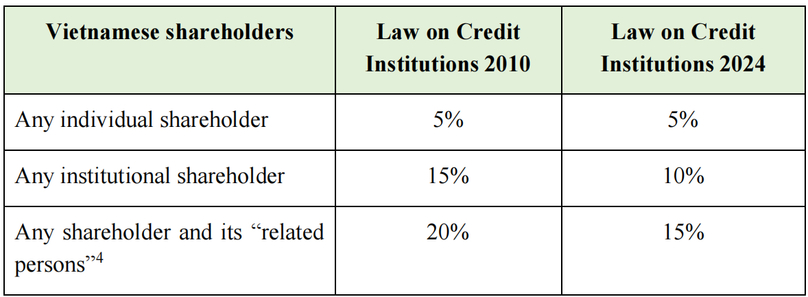
For avoidance of doubt, as clarified in Article 63.4 of the Law on Credit Institutions 2024, the above maximum ownership level in a Vietnamese credit institution does not apply to shareholdings of foreign investors and this matter shall be governed by the specific provisions to be issued by the Government.
Consequently, Article 210.5 of the Law on Credit Institutions 2024 requires a commercial bank where the ownership of a shareholder or a shareholder together with its related parties exceeds the statutory ownership limits specified in Article 55 of the old Law on Credit Institutions 2010 (the Exceeding Banks) to develop and implement an action plan and roadmap to ensure compliance with the new ownership limits set under the new Law on Credit Institutions (as outlined in the table above) (the Compliance Roadmap).
To provide further clarification on this requirement, the State Bank of Vietnam (SBV) issued Circular No. 52/2024/TT-NHNN on November 29, 2024 (Circular 52/2024), which takes effect on January 15, 2025.
Under Circular 52/2024, the Compliance Roadmap must be formulated and implemented according to the following steps and requirements:
– The applicable Exceeding Banks (except for commercial banks allowed for early intervention or under special control) must prepare the list of shareholders and related persons whose shareholding ratios in such banks (collectively, the Exceeding Shareholders) have crossed the ownership caps under the Law on Credit Institutions 2010. The statutory cut-off date for this list is June 30, 2024.
– The applicable Exceeding Banks shall cooperate with the Exceeding Shareholders to establish the Compliance Roadmap to ensure compliance with the ownership limits outlined in Article 55 of the Law on Credit Institutions 2010 first, followed by compliance with the limits set in Article 63 of the Law on Credit Institutions 2024.The Compliance Roadmap must have the following compulsory contents: (i) the Exceeding Shareholders’ detailed information; (ii) timeline of the Compliance Roadmap, which is determined by parties but must align with the restructuring plan/scheme of the Exceeding Shareholders or other decisions/documents approved by the competent authority of the Exceeding Shareholders (if any); (iii)implementation milestones, applicable remedies and actions for the Compliance Roadmap; and (iv) Exceeding Banks’ commitments regarding cooperation and urgingthe Exceeding Shareholders to comply with the Compliance Roadmap.
– Until the completion of the Compliance Roadmap, the shareholding ratios of Exceeding Shareholders must not be increased, except in the case of receiving dividends paid in shares. Furthermore, the Exceeding Shareholders are not allowed to receive dividends paid in cash for their exceeded shares until the Compliance Roadmap is completed.
The applicable Exceeding Banks must submit the Compliance Roadmap to the SBV no later than 120 days from January 15, 2025. The Inspection Department of the SBV may, for the safety of banking system, request for adjustment to the Compliance Roadmap as submitted to the SBV. The applicable Exceeding Banks are required to report to the SBV on quarterly basis during the implementation of Compliance Roadmap.
3. Debt repayment restructuring for customers suffered from typhoon Yagi
On December 4, 2024, the SBV issued Circular No. 53/2024/TT-NHNN, which provides regulations for credit institutions and foreign bank branches to restructure debt repayment terms for customers facing difficulties due to the impact and damage caused by typhoon Yagi, as well as the floods and landslides that followed the typhoon (Circular 53/2024). Circular 53/2024 takes effect immediately upon its issuance date.
In particular, credit institutions and foreign bank branches are entitled to restructure the terms of loan principal and interest repayment if the following conditions are met:
– Eligible customers include individuals and entities that (i) are located or having investment and business activities in the 26 provinces and cities specified in Circular 53/2024, including but not limited to Hanoi, Hai Phong, Thai Binh, Quang Ninh, and (ii) are assessed by credit institutions and foreign bank branches as facing difficulties and unable to repay the principal and interest on time as per the agreed contract due to the impact of typhoon Yagi but still being capable of repaying the full principal and interest according to the restructured repayment terms.
– Eligible customers have an outstanding principal balance arising before September 7, 2024 from lending or financial leasing activities, and the principal and interest repayment obligations will be due between September 7, 2024 and December 31, 2025.
– The outstanding debt balance of a loan that has been restructured remains within the payment term or is overdue by up to 10 days from the agreed repayment due date. Credit institutions and foreign bank branches may restructure the repayment term for the outstanding balance of debts that are overdue for more than 10 days and overdue between September 7, 2024 and December 16, 2024 when implementing the first debt restructuring in accordance with Circular 53/2024.
– The final repayment date for the outstanding balance of debts having restructured repayment term shall be determined in accordance with the customer’s level of difficulty, but shall not exceed December 31, 2027. Credit institutions and foreign bank branches shall not restructure repayment terms for debts that violate legal regulations.
– The consideration of restructuring debt repayment terms shall be carried out from December 4, 2024 (i.e. Circular 53/2024 effective date) until the end of December 31, 2025, with no limit on the number of times the repayment term can be restructured.
To ensure uniform implementation across the entire system, Circular 53/2024 requires credit institutions and foreign bank branches to issue internal regulations on restructuring debt repayment terms, which contain compulsory contents outlined in Circular 53/2024, and send a copy of this internal regulations to the SBV. Furthermore, they must also send SBV the reports in prescribed forms on the implementation of debt restructuring as well as on debt classification and the provision for risks in accordance with laws.
4. Amendments of regulations on certificates in insurance sector
November 29, 2024, the Ministry of Finance (MoF) issued Circular No. 85/2024/TT-BTC (Circular 85/2024) to amend and supplement several articles of Circular No. 69/2022/TT-BTC dated November 16, 2022 of the MoF (Circular 69/2022) on certificate on insurances, insurance agent, insurance brokerage, and insurance support (collectively, the Insurance-Related Certificate). Circular 85/2024 will take effect from January 15, 2025.
One of the most notable points introduced in Circular 85/2024 is that the Vietnam Insurance Development Institute (a public service unit under the Department of Insurance Supervision and Management) shall now be responsible for organizing the examination for insurance certificates, insurance broker certificates, certificates for insurance support, as well as for conducting exams, issuing, revoking, renewing, and converting insurance agent certificates.
Specific responsibilities of the Vietnam Insurance Development Institute shall include, among others: (i) issue the Regulations for the certification examsof the Insurance-Related Certificates; (ii) develop, manage, administer, operate, maintain, and upgrade the Certificate Examination Management System; and (iii) collect, manage, and use fees for the Insurance-Related Certificates.
As compared to Circular 69/2022, Circular 85/2024 outlines clarification on which entities shall be considered as foreign insurance training institutions. To be more specific, under Circular 85/2024, a foreign insurance training institution is an entity with the function of providing insurance training and falls in one of the following cases:
– A training institution that is part of or directly under a foreign insurance regulatory and supervisory authority, or a training institution designated by the foreign insurance regulatory and supervisory authority or mandated by the laws of that country to conduct training and issue certificates in the field of insurance;
– The ASEAN Insurance Training and Research Institute (AITRI); the Actuarial Society, which is an official member of the International Actuarial Association;
– Training organizations from countries that have mutual recognition agreements for insurance certificates with Vietnam;
– Training institutions belonging to foreign insurance groups, foreign reinsurance groups, and foreign insurance brokerage groups. These institutions must have the function of providing insurance training in accordance with the laws of the country where the group is headquartered or where the insurance training institution of the group is located; and
– Other foreign insurance training institution specified at laws.
Moreover, Circular 85/2024 also revises the cases where the insurance agent certificates shall be revoked to include the following circumstances:
(i) the candidate alters, falsifies, or forges personal identification documents (Identity Card/Citizen Identification Card/Passport) when participating in the exam;
(ii) an individual asks someone else to take the exam on their behalf;
(iii) the insurance company, branch of a foreign non-life insurance company, microinsurance provider, or individual commits fraud in the process of converting the insurance agent certificate; or
(iv) the certificate is revoked at the request of a competent state authority as stipulated by law.
Within three business days from the certificate revocation date, the organization responsible for conducting the exam must notify the list and information of the revoked certificates. Individuals whose certificates are revoked under the afore-mentioned cases will not be allowed to participate in subsequent exams within 12 months from the certificate revocation date.
You may like
-


Vietnam’s Exclusive Economic Zone boasts over 1,000 GW of wind power potential: report
-


Uncertainty weighing on real estate
-


Central Vietnam city seeks $1.84 bln for 15 projects in economic zone
-
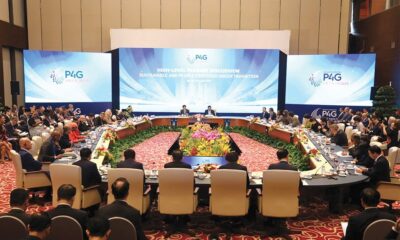

Green engagement rides high in Vietnam
-
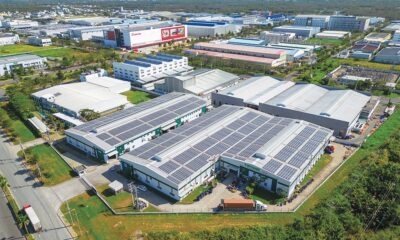

New standards being reached within green industrial parks
-
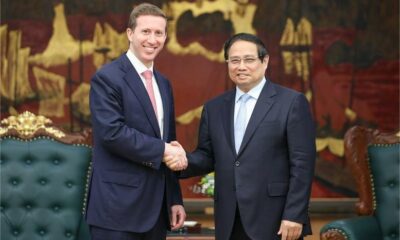

Vietnam PM asks Warburg Pincus to invest ‘further and faster’
Investing
Bac Giang International Logistics Centre launched
Published
8 months agoon
April 27, 2025Bac Giang International Logistics Centre was launched on April 22 with an investment of $168 million, and is expected to become a crucial link in the global supply chain.
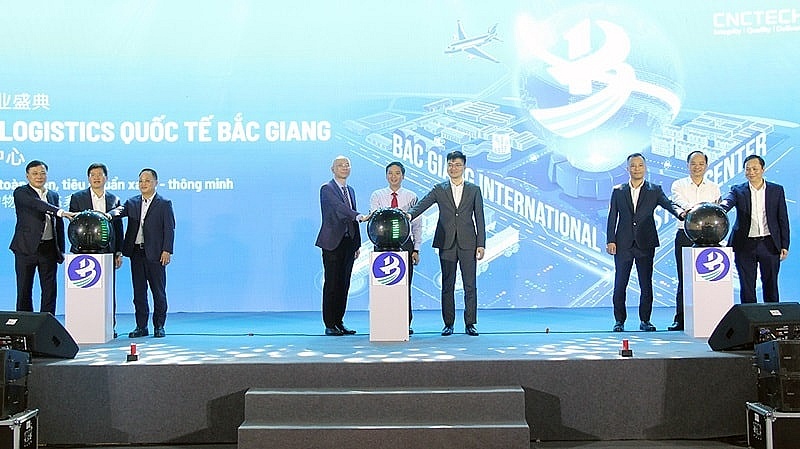 |
| Bac Giang International Logistics Centre launch |
Being invested by CNCTech Group, Dolphin Sea Air Services Corporation and Thien An Investment JSC, the logistics centre is located on National Highway 1A, which boasts first-class warehouse supply to meet the growing demand in the northern Vietnamese market.
Its strategic position within the golden economic triangle of Hanoi – Haiphong – Quang Ninh provides convenient connectivity to industrial zones and key logistics centres via national highways No.1A and No.37.
The centre is designed to meet growing demand for logistics infrastructure from businesses in Bac Giang and neighbouring provinces, positioning the area as a new node in northern Vietnam’s logistics network.
The project is a strategic product as a key component of the logistics spearhead in CNCTech Group’s industrial and logistics infrastructure ecosystem. It has been approved by the prime minister as a national level-II logistics centre, covering a planned area of 67 hectares.
At the launch ceremony, Chairman of Bac Giang People’s Committee Nguyen Viet Oanh said, “In recent years, the province’s socioeconomic development has made remarkable strides. Transportation, urban, industrial, and social infrastructure have been synchronously invested in and have yielded high efficiency. However, the province’s logistics service sector has not yet matched its potential, advantages, and socioeconomic development level. The logistics system remains fragmented, transportation costs are high, and trade delivery times are prolonged.”
Recognising this bottleneck, the local authorities have focused on directing the robust development of the logistics system, incorporating it into the provincial plan. This includes developing eight comprehensive logistics centres covering nearly 500ha, three inland container depots, and 33 inland waterway ports.
“Bac Giang, with its strategic location between Hanoi and border provinces, has long been known as a dynamic industrial hub. The remarkable development of the province’s industrial parks has created a solid foundation for the establishment of Bac Giang International Logistics Centre. This centre is not only located on vital transportation routes such as Hanoi-Lang Son Expressway but also directly connects to major border gates, optimising the transport of goods from Bac Giang to the world,” said Oanh.
 |
| A model of the logistics centre |
The project is not merely a warehousing facility, but also a symbol of the integration of modern infrastructure and advanced technology. The centre includes multifunctional warehouse areas, customs-controlled warehouses, non-tariff warehouses, and automated warehouses, meeting the needs of various industries. Notably, it integrates end-to-end logistics solutions, supporting businesses in optimising transportation costs and enhancing production efficiency.
With a long-term vision, the centre aims not only to optimise domestic supply chains but also to become a key connection point in the global logistics network.
Nguyen Van Hung, chairman of the Board of Members of CNC Tech Group, shared, “The establishment of this centre is a strategic step in developing Vietnam’s logistics infrastructure. We are committed to long-term and robust investment in this sector, as logistics is not just infrastructure but an indispensable part of enhancing the competitiveness of Vietnamese businesses on the international stage.”
Vietnam has taken strong action to promote green development among businesses, amid the country facing challenges in finance and technology.
Vietnamese Party General Secretary To Lam told the fourth Summit of the Partnering for Green Growth and the Global Goals 2030 (P4G), organised last week in Hanoi, that Vietnam is focused on strategic breakthroughs to prepare for a national development process that is fast, inclusive, and sustainable.
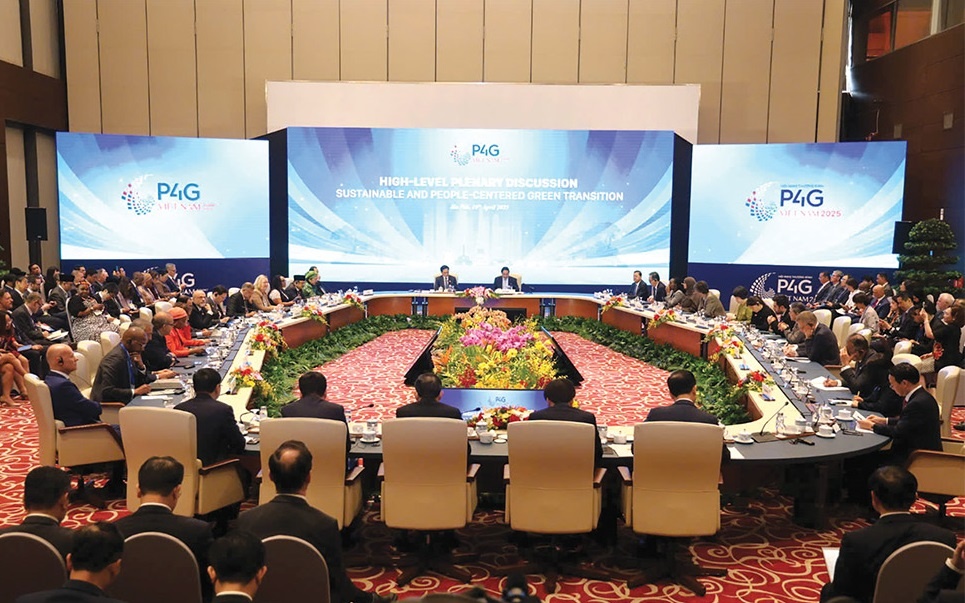 |
| The summit in Hanoi covered areas from finance and banking to agriculture and technology Photo: Dung Minh |
“We will strongly transform political commitments into practical actions, creating motivation for businesses and the whole society to participate in sustainable economic development, in which green institutions are the decisive foundation,” General Secretary Lam stressed at a hall attended by government leaders, UN representatives, diplomats, experts, and entrepreneurs.
General Secretary Lam also stressed that when it comes to green transformation, despite being a developing country with a transitional economy and limited resources, Vietnam has achieved some important results.
Besides making a 2050 net-zero commitment in 2021, Vietnam also endorsed six global initiatives at the time, on forest and land use, methane, clean power transition, sustainable food and agriculture, and more.
“Vietnam is now a leading country in supplying renewable energy in ASEAN, with wind and solar power capacity accounting for two-thirds of ASEAN’s total capacity,” he said.
“Additionally, Vietnam is also a good example of encouraging sustainable agriculture. The initiative to develop one million hectares of high-quality and low-emission specialised rice is a pioneering model that many partners and international organisations are interested in.”
A greener future
Vietnam is an active and responsible member of all multilateral mechanisms and major initiatives on green growth and energy transition such as the Paris Agreement on climate change, the Just Energy Transition Partnership, and the P4G.
“However, as a developing country with a transitional economy, we also face many challenges in terms of financial resources, technology, personnel, and resilience to the impacts of climate change and geopolitical fluctuations globally,” said General Secretary Lam.
The summit adopted the Hanoi Declaration, strongly affirming commitments to sustainable growth with people at the centre, and a determination to collaborate responsibly in addressing current global challenges. Vietnam is expected to enjoy continued support from the international community in its journey to a green economy including energy transition.
According to the World Bank, to ensure sufficient funding for responding to climate change, mobilising domestic finance is possible, but external support is needed.
Overall, Vietnam’s total incremental financing needs for the resilient and decarbonising pathways could reach $368 billion over 2022–2040, or approximately 6.8 per cent of GDP per year.
The resilient pathway alone will account for about two-thirds of this amount, as substantial financing will be required to protect the country’s assets and infrastructure as well as vulnerable people.
The cost of the decarbonising pathway will mainly arise from the energy sector – investments in renewables and managing the transition away from coal might cost around $64 billion between 2022 and 2040. All the figures are in net present value terms at a discount rate of 6 per cent.
This $368 billion in financing needs will include $184 billion from private investments or about 3.4 per cent of GDP annually, $130 billion or about 2.4 per cent of GDP annually from the state budget; and $54 billion or about 1 per cent of GDP per year from external sources.
Choi Youngsam, South Korean Ambassador to Vietnam, said that within the P4G framework, South Korea and Vietnam have completed or are currently implementing joint projects in areas such as food and agriculture, energy, water, and urban development.
“Looking ahead, both sides are expected to broaden and deepen their partnership under the P4G framework,” he said.
At the P4G Summit held in Seoul in May 2021, the two governments signed the Framework Agreement on Cooperation in Response to Climate Change, laying a solid policy foundation for the implementation of international emissions reduction ventures.
“On this basis, I hope that South Korea will leverage its technological expertise and financial resources to carry out greenhouse gas emission reduction projects in Vietnam, with both countries mutually recognising the results,” Ambassador Youngsam said.
“This would contribute to establishing a win-win model of emissions reduction cooperation. At the same time, I look forward to seeing active engagement from South Korean enterprises possessing green technologies, in close collaboration with the Vietnamese government.”
Encouraging developments
Deputy Minister of Science and Technology Hoang Minh said at a policy dialogue on the sidelines of the P4G 2025 that the active participation and strong cooperation from stakeholders – from the public and private sectors to international organisations – can help materialise Vietnam’s aspiration of an efficient and sustainable innovative startup ecosystem.
“Innovation, creative entrepreneurship and collaboration are key to solving environmental problems, while encouraging the development of a circular economy,” he said.
Vietnam currently has over 4,000 innovative startups, including two unicorns valued at over $1 billion, 11 companies valued at over $100 million, more than 1,400 startup support organisations, 202 co-working spaces, 208 investment funds, and 35 business promotion organisations. Among these, it is estimated that around 200–300 companies focus on green transition, covering areas such as renewable energy, environmental technology, sustainable agriculture, and the circular economy.
According to the Vietnamese Ministry of Foreign Affairs, hosting the fourth P4G Conference is of great significance to Vietnam. It is aimed to boost its role as a good friend, a reliable partner, and a responsible member of P4G and the international community. Moreover, it is also aimed to reaffirm its commitment to sustainable development, energy transition, and the goal of carbon neutrality by 2050. Besides that, it is aimed at contributing to raising awareness of international cooperation and encouraging the role and voice of developing countries in the sector of green growth and sustainable development.
| Pham Minh Chinh, Prime Minister
For Vietnam, together with digital transformation, we identify green transition as an objective necessity, a key factor, and a breakthrough driving force to promote rapid growth and sustainable development. This aligns with the strategic goal of becoming a developing country with modern industry and upper-middle income by 2030, and a developed, high-income country by 2045, while also contributing to the gradual realisation of Vietnam’s commitment at COP26 to achieve net-zero emissions by 2050. From practical experience with initial positive results, especially in renewable energy, green agricultural development, and participation in multilateral mechanisms and initiatives on green transformation, as the host of the fourth P4G Summit, Vietnam has three suggestions for discussions which pave the way for further cooperation in the coming time. First is to perfect green mindset, with a focus placed on the development of science and technology, innovation, and digital transformation linked to green growth. This includes recognising that green resources stem from green thinking, green growth is driven by green transition, and green resources arises from the green awareness of people and businesses in nations and regions throughout the world. Second is to build a responsible green community, in which, the government plays a guiding role, encouraging, and ensuring a stable and favourable institutional environment for green growth. The private sector functions as a core investor into technological development and the dissemination of green standards. The scientific community take the lead in developing green technologies and training green human resources. Meanwhile, citizens continuously enhance their green awareness, truly becoming beneficiaries of the outcomes of green transformation. Thirdly, it is necessary to promote international cooperation and robust multilateral green cooperation models, particularly public-private partnerships, South-South cooperation, North-South cooperation, and multilateral cooperation frameworks. This is aimed at removing institutional barriers, enhancing access, and speeding up the flow of green capital, green technology, and green governance. Developed countries should take the lead in fulfilling commitments to provide financial, technological, and institutional reform support. Meanwhile, developing countries would need to leverage their internal strengths and effectively utilise external resources. |
Investing
Public-private partnerships a lever for greener innovation
Published
8 months agoon
April 26, 2025Public-private partnerships are no longer a supporting mechanism, but a strategic pillar in the global pursuit of the green transition.
The high-level dialogue between government leaders and businesses at the 2025 P4G Vietnam Summit last week, chaired by Prime Minister Pham Minh Chinh, brought together senior officials, global experts, international organisations, and private sector leaders.
They recognised that the climate crisis, digital transformation, and resource depletion are converging in ways that demand not only innovation, but deep and long-term collaboration between the public and private sectors.
UN Deputy Secretary-General Amina J. Mohammed acknowledged Vietnam’s leadership in renewable energy, noting its potential to attract trillions in sustainable investment.
“Emerging economies must accelerate the adoption of new investment models, particularly those that align private capital with green infrastructure priorities. Governments must work with the private sector to expand ambition, strengthen accountability, and deliver real impact,” she said.
From Italy, Prime Minister’s Climate Envoy Francesco Corvaro stressed that public-private partnerships (PPPs) are indispensable in addressing climate finance gaps. Drawing from Italy’s experience, he underscored the importance of public investment as a risk mitigator, enabling private sector participation in clean energy and smart infrastructure projects.
“Public investment can unlock private capital, but local authorities must lead with clear priorities and long-term vision,” Corvaro noted. “You can’t talk about renewables, AI, or digital infrastructure without modern, resilient grids, and that requires strong public-private alignment.” he said
Alejandro Dorado, Spain’s High Commissioner for Circular Economy, argued that the case for stronger PPPs lies at the intersection of two accelerating forces: the environmental-climate crisis and a wave of disruptive technologies.
“In a world where AI, green technologies, and digitalisation are reshaping the global economy, the clock is ticking. According to the Intergovernmental Panel on Climate Change, we have less than a decade to prevent irreversible climate disaster. Meanwhile, the World Economic Forum has identified biodiversity loss as one of the most severe economic risks,” he said.
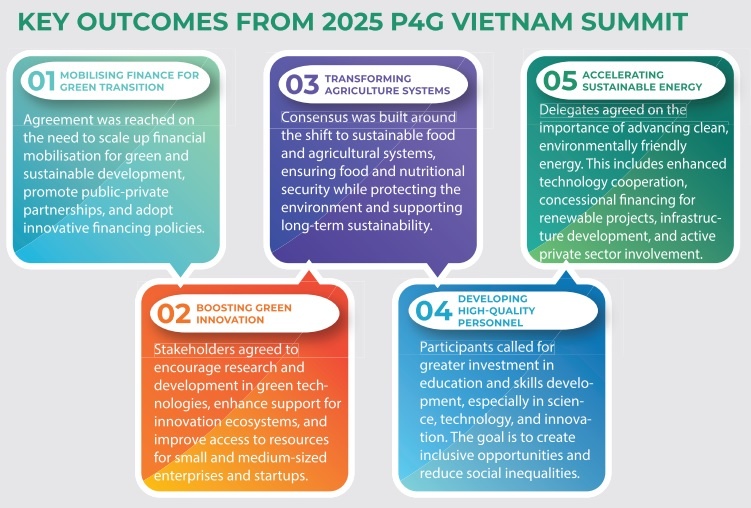 |
Dorado added that while multilateralism is being questioned or weakened in some quarters, the need for cooperation has never been more urgent – both to solve environmental challenges and to harness the transformative potential of innovation.
“No government or business can tackle these crises alone. Public authorities must provide the regulatory frameworks, fiscal incentives, and infrastructure deployment needed at scale to safeguard the common good,” he stressed.
From the business side, Stuart Livesey, country representative of Copenhagen Infrastructure Partners (CIP), provided a frank but optimistic outlook. Livesey stated CIP’s commitment to supporting Vietnam’s transition, but emphasised the need for enabling conditions.
“What we seek are clear, bankable projects underpinned by stable regulatory frameworks, collaborating with strong local partnerships. This is where public-private cooperation becomes not just helpful, but essential,” Livesey noted. “Over the next 10-15 years, the offshore wind sector and green energy consumers will trigger massive demand for new technologies, digital solutions, and skilled labour.”
To meet this demand, CIP is investing not only in infrastructure, but also in capacity building, research and development, and local supply chain development through partnerships with Vietnamese universities.
Still, he acknowledged barriers. “Technological application and innovation in green projects face challenges, from long-term financing constraints and skilled labour shortages to fragmented policy signals. These are not unique to Vietnam, but they require proactive, tailored local solutions,” he said. “Addressing issues such as grid availability, regulatory clarity, and inter-ministerial coordination will be critical.”
Tim Evans, CEO of HSBC Vietnam, stated that the banking sector is ready to facilitate green finance, particularly in sectors aligned with national climate targets.
“We see ourselves as a bridge between global capital and local sustainability goals. The clearer the pipeline of bankable, climate-aligned projects, the faster we can move capital,” he noted. “What’s crucial now is consistency in policy and coordination among stakeholders to ensure these projects reach maturity.”

Bac Giang International Logistics Centre launched

Vietnam’s Exclusive Economic Zone boasts over 1,000 GW of wind power potential: report

Uncertainty weighing on real estate

Central Vietnam city seeks $1.84 bln for 15 projects in economic zone

